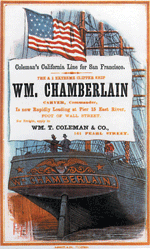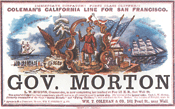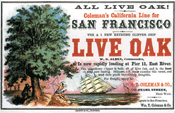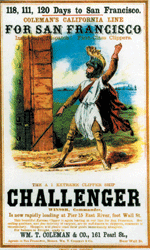Ship Sailing Cards
By Carol J. Perry
New England antiques dealers like to tell this story. It seems that a number
of years ago, when a gentleman from an old Boston family passed away, there was
a bit of a squabble among the heirs over an old desk. Everyone knew that the old
fellow had always promised the desk to his young grandson, but since that gift
had not been included in the will, one of the aunts had "pulled rank" and
demanded that the desk be auctioned along with the rest of the furniture. Sadly,
the young man agreed, and when the aunt told him to "clear out all that junk"
and to "keep anything you want" from the drawers and cubbyholes in the desk, he
did so.
Little did that mean old auntie know that in a bottom drawer, secured
with a rubber band, was an inch-high stack of colorful illustrated cards which,
as it turned out, were worth many times the value of the desk. Those brightly
hued bits of pasteboard were clipper ship advertising cards, also known as
dispatch cards, dating from the mid-19th century.
Is the story true? Or is it
perhaps one of those urban legends which persist in the antiques business?
Either way, it points to the fact that, in today's market, just one nice
19th-century clipper ship card in good condition can bring to its owner
thousands of 21st-century dollars.
We've all seen and admired paintings of
clipper ships, those graceful and beautiful vessels with billowing sails and
sleek narrow hulls. The ships were developed by american shipbuilders around
1840. The major attribute of these ships, however, was not beauty, but speed.
Back in those days, a journey by sea from the ports of New York or Boston to San
Francisco, via Cape Horn, took the better part of a year. But the clippers could
cover the same distance in 120 days or less. Even so, with the advent of
steam-powered ships and with the coming of the railroad over land, the days of
the clipper ship were numbered.
When gold was discovered in California,
clippers had a bit of a resurgence. Traveling by steamship was expensive, and
cargo space was limited. Gold prospectors soon figured out that, aboard the fast
all-sail vessels, they could carry their equipment and supplies and some
provisions for a lot less than they'd pay in the high-priced markets of
California.
In an attempt to attract more trade, ship owners began to
advertise with "sailing announcement cards." The cards were quite small, only
about four by six and a half inches. They took up such little room that shipping
firms could fit six or seven of them in one window, hopefully informing the
public of a sailing in time for the company to pick up enough passengers and
goods to give them a full and profitable cargo for the long voyage. The cards
didn't often include sailing dates, but used such phrases as "sailing shortly."
Although that may have proven inconvenient for some passengers, many ships
needed a full cargo and sometimes had to wait for other vessels to deliver
merchandise to be shipped.
Some fortunate technological advances in the
printing field coincided nicely with the need to advertise the clippers. It was
possible to produce clear, bright color on enamel-coated cardboard stock.
Sometimes, the clipper ship cards were printed in as many as seven different
colors, utilizing the economical letterpress. A few of the cards were
lithographed. Some authorities believe that the sailing cards are historically
significant as America's earliest form of multi-color business
advertising.
Many of the cards, quite naturally, portray the ships
themselves. But some show knights and warriors, while others depict mythological
figures, Native Americans or women. Some feature portraits of the person for
which the vessel was named, like the Florence Nightingale, the Andrew Jackson
and the Daniel Webster. Quite a few depend on the artist's skill at fancy
lettering, with handsome renderings of the vessel's name as the
illustration.
Even though there were undoubtedly thousands of these cards
printed, there are relatively few in existence today. It was, after all, cheap
advertising, and once the vessels had sailed, there was little point in saving
the cards. There was only so much window space, and there were new cards
arriving to take the place of the old ones. Fortunately for collectors, various
companies apparently kept cards as part of their record-keeping procedures. Some
of the most famous vessels didn't really require much advertising because their
passenger lists and cargo facilities were usually booked far in advance. For
instance, the beautiful and famous clipper ship Flying Cloud, designed and built
by the legendary Donald McKay, was so fast that her record-setting voyages (89
days from New York to San Francisco in 1851 and again in 1854) assured that
everybody interested knew the dates of arrival and sailing. There is only one
known example of a Flying Cloud sailing card.
Clipper ship sailing cards date
mostly between the 1850s and the 1860s when competition was heavy between the
many ship lines. But the clippers eventually lost the race for speedy passage to
their far less glamorous cousins, the steamships, and the advent of
coast-to-coast rail travel was the final blow. Some sources report that gold
fever caused a good many crew members to leave their ships and head for the gold
fields. Some clippers were even abandoned in San Francisco Bay and auctioned off
to provide timber for the city's building boom. In the early 1860s, the Civil
War disrupted shipping trade, too, and soon the sailing cards faded from the
American scene.
It is estimated that only about 3,000 clipper ship cards
survive today. Most of these are in museum collections, but every so often, a
few of them show up, perhaps in a grandfather's desk drawer or tucked between
the pages of an old book. Private collections sometimes appear for sale at
auction or on the web.
Exhibits of cards can be viewed in several museums,
including:
· The Peabody Essex Museum; East India Square, Salem, Mass.
·
The New York Historical Society; Two West 77th Street, New York, NY.
· The
Australian National Maritime Museum; Darling Harbor, Australia.
To view cards
for sale or to check current prices, go to www.tenpound.com/clippercard
|

This card advertising the
Wm. Chamberlain is the only known card to depict a
ship's stern. Scarce, one sold
recently for $2,500.

This card for the Gov. Morton shows an Indian chieftan, Plymouth Rock, an
eagle and
the Clipper and the Mayflower
in the background. It is listed
for
$2,250.

Some cards gave only the
month and day of sailing, but
not the year, such as
this one
for the Osborn Howes that only lists a sail date of Feb. 21.

The Live Oak featured an oak tree with a bear hiding behind
it. The copy says
the ship is
"built all of live oak." Undated,
it sold for $2,250.

The Challenger was noted
for bringing back from
Shanghai the most valuable
cargo of tea and silk ever
carried in one ship. One of
these cards sold recently
for $500. |